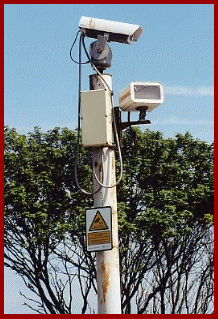| ||||||||||||||||||||||||||||||
Welcome to the | ||||||||||||||||||||||||||||||
 | ||||||||||||||||||||||||||||||
 | ||||||||||||||||||||||||||||||
The complete A to Z ... | ||||||||||||||||||||||||||||||
If you were going to engineer a cross between conventional fibre optic and microwave transmission, you’d probably end up with a hybrid system such as the laser link. If you consider how fibre optic uses a relatively low power Light Emitting Diode (LED or Laser LED), to beam pictures down an extremely thin glass strand, the Laser Link works on exactly the same principle but with a higher power emitter and no fibre in between. This technique has actually been around for some years now, and if there were any doubts about its capabilities, you need only look at the high end transmitter / receiver systems designed for the Broadcast TV industry; which cost almost as much as a complete, small ‘town centre’ CCTV scheme! As with microwave, the transmitter and receiver need to be positioned ‘line of sight’, without any objects in between. Unlike microwave where a small residue signal can sometimes bounce off certain objects, Laser Link is a true point to point system, relying on a coherent beam of laser light as the carrier for the real time video signal. With various power output transmitters available, ranges can be measured in terms of a few hundred metres, up to 5 kilometres. In practice, this technique is generally regarded as a useful quick fix for distances of up to 1.5 kilometres; particularly as compared to microwave, it is significantly more expensive. In order for the units to function correctly, alignment is generally critical, with even a slight deviation off the ‘sweet spot’ causing a reduction in overall transmission integrity; it’s a bit like using the infra red remote control for your television (point it at the wall, and it's unlikely to increase the volume; unless of course you happen to have particularly loud wallpaper!). The units themselves have the appearance of normal weatherproof camera housings, and in one respect, a very similar but vital requirement. Although not significantly weighty in themselves, the transmitter and receiver units must be securely bolted down, to absolutely minimise any wind induced movement; indeed strapping a transmitter to a lamp post on a high street blessed with an abundance of heavy lorries, may not necessarily be a preferred option; if everytime a large vehicle goes by, the slightest movement in the support could momentarily lose the pictures. | ||||||||||||||||||||||||||||||
 | ||||||||||||||||||||||||||||||
IMPORTANT: No material may be reproduced, copied or redistributed from this site, © doktorjon.co.uk 2004 - 2008 Homepage...:...Gateway...:...Technical Gateway....:....Quickfind Index....:....Equipment Directory | ||||||||||||||||||||||||||||||

